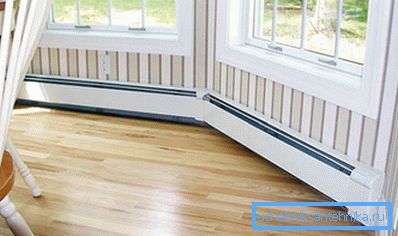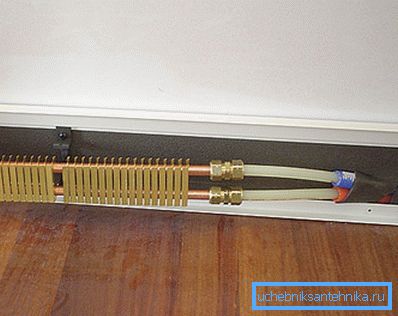Baseboard heating - features and device
Not so long ago, it was possible to realize water heating only with the help of radiators, however recently there have been many alternative options that have been actively used by owners of houses and apartments. One of these is water baseboard heating, which, in fact, is devoted to this article.

Features of baseboard heating
Merits
The principle of any heating is based on the fact that the hot air flow rises, while the cold one at this time descends and is heated by the heating device. This process is called convection.
From this scheme it follows that the most efficient heating occurs when the heat source is located near the floor itself. Thus, the baseboard heating system is more efficient than radiator heating.
In addition, this solution has some other advantages, which are listed below:
- Heat is evenly distributed in the room.
- The presence of infrared radiation, which is positively perceived by the human body.
- There is no problem of accumulation of moisture on the walls and ceiling, which often leads to mold.
- You can install such a system yourself, without the help of specialists.
- Thanks to the temperature controllers, you can adjust the temperature separately for each room.

- Due to its effectiveness, such a system is more economical.
- Baseboards will not spoil the look of the interior with their appearance, as happens when using radiators.
Tip! The baseboard heating system can also be used to cool the premises during the summer period. To do this, the tubes must be filled with cold liquid, although it must be above the dew point to avoid condensation.

disadvantages
Like any other system, the heating under consideration has some of its minuses:
- The high price of heating elements, due to the high cost of materials from which they are made.
- The length of one circuit should not exceed fifteen meters, otherwise the efficiency of the system will decrease.
- The room in which the plinth heating is implemented should not be cluttered with cabinet furniture, as it will reduce the efficiency of the system.
- It is impossible to install different decorative plates on the radiator, as they can reduce the efficiency of the system.

Heating device
Plinth water heating in many ways resembles the usual radiator, except that the heating elements are small and hidden in the baseboards, respectively, the pipeline is also hidden behind the panels.
Thus, the system consists of the following elements:
- Contour distribution collector;
- Radiator plinth blocks;
- Plinth for heating pipes, hiding wiring.
The remaining elements are the same as in conventional heating - a circulating pump, boiler, expansion tank, etc. Separately, consider radiator units, which consist of several elements:
| Wall plate | Serves as the main one to which the radiator is attached. |
| Heat exchanger | It consists of two copper tubes, on which vertical brass or aluminum lamellae are mounted. |
| Aluminum box | Hides the heat exchanger and thus performs a decorative function. The box usually has top and bottom slots for convection air. The height of the box leaves about 140 mm, and the width - 22 mm. |
For the supply of coolant to the radiator skirting and removal of cold liquid, special plastic tubes are used.
Note! The maximum temperature in the system should not exceed 85 degrees, and the pressure - 3 atmospheres. Otherwise, the plastic tubes may be damaged, causing an accident.

Installation Features
As mentioned above, the installation of the heating system under consideration can be performed independently.
Brief instruction is as follows:
- First of all, a wall plate is fastened around the perimeter of the room.. In some cases, simply hooks that hold the radiator are used.
- Next, the radiators themselves are mounted, to which the supply and return pipes are connected.. It should be noted that the plinth wiring of heating pipes can be carried out even after finishing works, if, of course, it is not planned to conduct pipes in the floor or walls.
- After completing all connections, the system should be filled with fluid, releasing all the air. Antifreeze or antifreeze can be used as a liquid.
- Next, the heating is started, and all connections are thoroughly checked.
- In the event of faults, they are eliminated.
- At the end of the work, an aluminum box is installed, which gives the structure an attractive look.

Note! When you first start the system should touch your hands to check for the presence of impassable areas. If they are found, release air from them. This will ensure uniform heating of the system.
Here, in fact, and all the features of installation of baseboard heating. All other actions are the same as in the performance of the radiator system.
Conclusion
Room heating with radiator baseboards is an excellent alternative to traditional batteries. However, before you make a choice, you should consider some of the shortcomings of the system, which are listed above.
From the video in this article, you can learn some additional information on this topic.